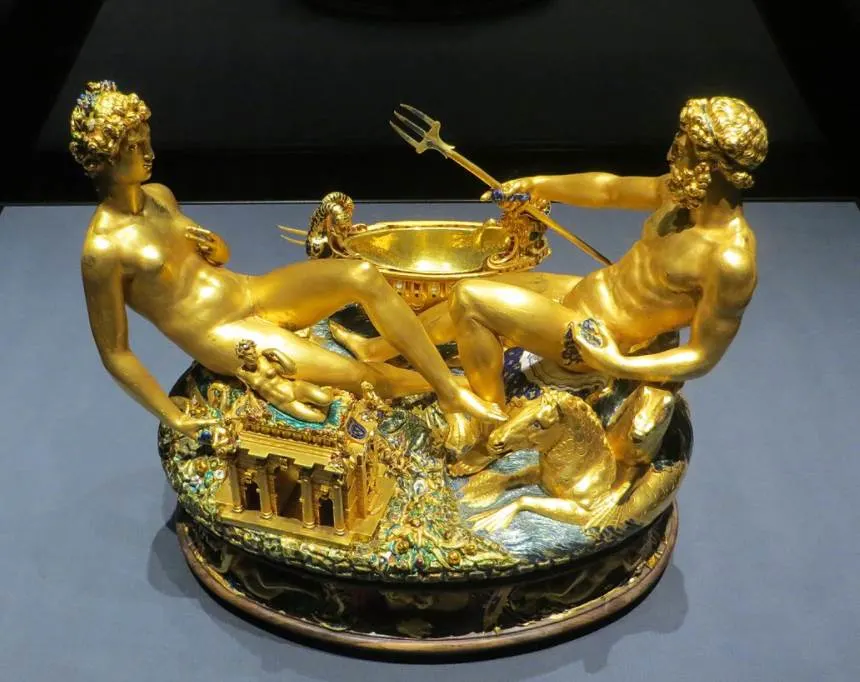The life of Benvenuto Cellini (1500-1571) was one of multiple ups and downs, mainly because of his short temper and often violent behavior. This makes it no surprise that he started writing his autobiography at the age of 58 as he had quite a several interesting stories to tell.
He was also one of the most renowned sculptors and goldsmiths of the 16th century, sought after by the most important people in Europe at the time.
Let’s take a closer look at some of the most interesting facts about the Cellini Salt Cellar, one of the famous works that the Mannerist artist produced at the height of his career.
1. The table decoration was produced during the 1540s
The Cellini Salt Cellar is a gold table sculpture that was intended to be used as a salt and pepper cellar. It’s considered to be one of the ultimate masterpieces of the renowned Italian artist of the Late Renaissance named Benvenuto Cellini.
The artist was born in Florence but moved around quite a bit, mainly to avoid trouble with the law as he proclaimed in his autobiography that he committed several murders.
His most remarkable escapade was his self-proclaimed assassination of Charles III, Duke of Bourbon, an event that resulted in the Sack of Rome in the year 1527. Many art historians believe that this event marked the end of the High Renaissance.
Cellini was convicted of another crime in 1539 and survived an assassination attempt himself that same year. His talent and powerful friends eventually ensured that he was set free, allowing him to complete this remarkable work of art in 1543.

2. It was commissioned by the King of France
Cellini got help from Cardinal d’Este of Ferrara to avoid being executed while being enprisoned at the Castel Sant’Angelo in Rome. From here he managed to flee to France where he was hired by nobody else than King Francis I (1494-1547).
It’s during this period when he was working at the Château de Fontainebleau for the French court, that he was commissioned to produce a salt cellar which is now referred to as the Cellini Salt Cellar.

Cellini didn’t manage to avoid getting in trouble at the French court and got into constant conflict with various people. He eventually returned to Florence a few years after he arrived in France and was welcomed with open arms in his home city.

3. The sculpture is an allegory of the Cosmos
This incredible work of art is so much more than merely a salt cellar, although it could perfectly be used to hold salt and pepper. The elaborately decorated gold sculpture can be perceived as an allegory of the entire Cosmos.
It features the following elements:
- A male deity named Neptune represents the sea.
- A female deity named Tellus represents the earth.
- A temple near the female deity which could be used as a pepper holder.
- The 4 winds and times of the day are depicted on the base.
The sculpture also features the coat of arms of King Francis I of France, a metaphor of the man who commissioned the work ruling over the Cosmos.
4. It was produced with 4 different types of material
Although Cellini’s father pushed him to pursue an artistic career in music, his profession, the young Cellini was a lot more interested in molding precious metals. His father reluctantly agreed to have him trained as a goldsmith at the age of 15.
This means that the artist already had vast experience by the time he produced this work as he was already in his early 40s by then.
He was able to produce this work relatively fast because he already created a model for this type of salt cellar way earlier while he was still working for Cardinal Ippolito d’Este.
Although the work appears to be completely made of gold, it features 4 different materials:
- Gold
- Enamel
- Ebony
- Ivory

5. It’s a unique work of art in Cellini’s oeuvre for a particular reason
One of the most remarkable facts about the Cellini Salt Cellar is that although he had been a goldsmith since he was a teenager, it’s the only artwork made in gold that can be positively attributed to Cellini.
That’s not because he didn’t produce more works because many of these have been lost in history. Some of these lost artworks were a gold chalice produced for Clement VII and a gold cover for a prayer book which he offered as a gift for Pope Paul III
He also produced 3 large silver statues of Jupiter, Vulcan, and Mars during his stay in France, but these commissions for King Francis I have been lost as well.
6. How big is the Cellini Salt Cellar?
You don’t expect table decoration that is intended to hold salt and pepper to be of a monumental scale, and it isn’t. The Cellini Salt Cellar is a relatively small work of art.
It has the following dimensions:
- Height: 26 centimeters (10 inches)
- Width: 33.5 centimeters (13.2 inches)
- Depth: 21.5 centimeters (.46 inches)

7. Where is this artwork located today?
It’s clear that one of the successors of King Francis I of France didn’t appreciate this extraordinary work of art as he should. King Charles IX of France (1550-1574) gave it away as a gift to Archduke Ferdinand II of Tyrol.
It was then added to the Habsburg collection and decorated Ambras Castle for multiple centuries. This 16th-century Renaissance building is located in the mountains above the Austrian city of Innsbruck and stayed here until the 19th century.
When the Kunsthistorisches Museum in Vienna was completed in the late 19th-century, it was put on display in the most famous museum in Austria and remains in its collection today.

8. This work of art has something in common with the Mona Lisa
What does a gold table sculpture named the Cellini Salt Cellar have in common with the Mona Lisa Painting, Leonard da Vinci’s masterpiece on display at the Louvre Museum in Paris?
The fact that both artworks were once stolen from the museum they are housed in. The Mona Lisa underwent this faith in 1911 and was only returned to the Louvre museum in early 1914.
The Cellini Salt Cellar was stolen from the Kunsthistorisches Museum in Vienna on May 11, 2003, and was only recovered by police on January 21, 2006. The thief had buried it in a forest in the town of Zwettl, Austria. It was subsequently returned to the museum and the thief was apprehended.
This event has resulted in the sculpture being insured for nearly $70 million today!

